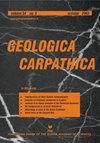Detrital zircon geochronology of Pliocene deltaic sediments in the Marmara region (Turkey): Implication for sedimentary provenance and morphotectonic evolution
IF 1.5
4区 地球科学
Q4 GEOSCIENCES, MULTIDISCIPLINARY
引用次数: 0
Abstract
: The İstanbul Pliocene deposits consist of an alternation of sand, clay, and coal in the northern part of İstanbul that characterizes a delta plain deposit on the southern coastal line of the Black Sea. The Pliocene sediments, which are located conformably on the fluvial sediments consisting of coarse clastics, are about 80 meters thick and outcrop as isolated patches in Şile in the east of the İstanbul Strait (Bosphorus) and Kısırkaya in the west. The U/Pb detrital zircon ages obtained from the sands of Kısırkaya and Şile region showed that the Pliocene deposits contain Proterozoic (2396 ± 72 – 542.4 ± 7.9 Ma), Paleozoic (540 ± 12 – 258.9 ± 5.2 Ma), Mesozoic (248.8 ± 4.4 – 71.8 ± 1.2 Ma), and Cenozoic (63 ± 1.8 – 22.18 ± 0.95 Ma) zircons derived from a piedmont plateau. Presence of the youngest Oligocene–early Miocene zircons (22.18 ± 0.95 – 31.1 ± 1.2 Ma) reveals that the source of this succession may be the Northwest Anatolia and/or northern Aegean region where magmatic rocks of the same age crop out. In addition to the zircon data in the sandy deposits, trace element geochemistry also shows that the drainage basin of the Pliocene rivers transporting clastics to the basin is located in the southwestern region of İstanbul and flowed into the Black Sea before the formation of the Marmara Sea. These rivers would have been blocked in the early Quaternary by the Marmara Sea depression, which was formed by extensional faults, the product of an approximately N–S extensional tectonic regime in the region. This tectonic regime caused the rapid uplifting of the İstanbul region and the Istranca Mountains in the north of the Marmara, and the eroded flattened areas called the Bursa–Balıkesir plateau in the south, in the form of horsts. Subsequently, before the North Anatolian fault reached the region, it formed deformation structures under the effect of dextral shear in a wide zone in the Marmara region. This tectonic regime was ended when the North Anatolian fault reached and cut the Marmara Sea region in the Latest Quaternary.土耳其马尔马拉地区上新世三角洲沉积碎屑锆石年代学:沉积物源和形态构造演化意义
: İstanbul上新世沉积物由İstanbul北部的砂、粘土和煤的交替组成,是黑海南部海岸线三角洲平原沉积物的特征。上新世沉积物整合于İstanbul海峡(博斯普鲁斯海峡)东部Şile和西部Kısırkaya,厚度约为80米,呈孤立斑块出露。Kısırkaya和Şile地区砂体的U/Pb碎屑锆石年龄表明,上新世沉积层含有源自山前高原的元古代(2396±72 ~ 542.4±7.9 Ma)、古生代(540±12 ~ 258.9±5.2 Ma)、中生代(248.8±4.4 ~ 71.8±1.2 Ma)和新生代(63±1.8 ~ 22.18±0.95 Ma)锆石。最年轻的渐新世-早中新世锆石(22.18±0.95 ~ 31.1±1.2 Ma)的存在表明,这一序列的源区可能是安纳托利亚西北部和/或爱琴海北部地区,那里有相同年龄的岩浆岩。除了砂质沉积物中的锆石资料外,微量元素地球化学也表明,向盆地输送碎屑的上新世河流的流域位于İstanbul西南地区,在马尔马拉海形成之前流入黑海。这些河流可能在第四纪早期被马尔马拉海坳陷所阻断,马尔马拉海坳陷是由伸展断裂形成的,是该地区近南北向伸展构造体制的产物。这种构造机制导致了马尔马拉北部的İstanbul地区和伊斯特兰卡山脉的快速抬升,以及南部以地丘形式被侵蚀的平坦地区Bursa-Balıkesir高原。随后,在北安那托利亚断层到达该地区之前,在马尔马拉地区广泛的区域内,在右旋剪切作用下形成变形构造。晚第四纪北安那托利亚断裂到达并切断马尔马拉海地区,结束了这一构造格局。
本文章由计算机程序翻译,如有差异,请以英文原文为准。
求助全文
约1分钟内获得全文
求助全文
来源期刊

Geologica Carpathica
地学-地球科学综合
CiteScore
2.40
自引率
23.10%
发文量
26
审稿时长
>12 weeks
期刊介绍:
GEOLOGICA CARPATHICA covers a wide spectrum of geological disciplines including geodynamics, tectonics and structural geology, volcanology, stratigraphy, geochronology and isotopic geology, karstology, geochemistry, mineralogy, petrology, lithology and sedimentology, paleogeography, paleoecology, paleobiology and paleontology, paleomagnetism, magnetostratigraphy and other branches of applied geophysics, economic and environmental geology, experimental and theoretical geoscientific studies. Geologica Carpathica , with its 60 year old tradition, presents high-quality research papers devoted to all aspects not only of the Alpine-Carpathian-Balkanian geoscience but also with adjacent regions originated from the Mediterranean Tethys and its continental foreland. Geologica Carpathica is an Official Journal of the Carpathian-Balkan Geological Association.
 求助内容:
求助内容: 应助结果提醒方式:
应助结果提醒方式:


